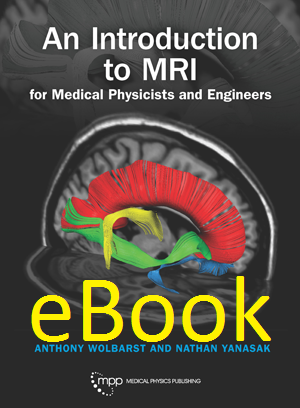
An Introduction to MRI for Medical Physicists and Engineers
Author: Anthony Wolbarst and Nathan YanasakISBN: 9781930524583
Published: June 2019 | 318 pp | eBook
Price: $ 120.00
Journal of Medical Physics, AAPM | JAN 2021
DESCRIPTION
Anthony Wolbarst, together with coauthor Nathan Yanasak, have produced a well-written and approachable book addressing the physics of magnetic resonance imaging (MRI).
PURPOSE
The book is well-suited for a graduate course on MRI, as it provides an excellent framework for didactic instruction. Advanced topics, including Fourier analysis and k-space, are explained incrementally with increasing levels of detail to allow readers new to the field to grow their knowledge.
AUDIENCE
The book is written at the beginning graduate level for medical physicists, bioengineers, and other imaging scientists. It provides a thorough grounding in the underlying physics. Other readers, such as radiologists with a strong interest in MRI physics, will also find this book of interest.
CONTENT/FEATURES
As with many books in the field, the material is presented at multiple levels. The book begins by giving a non-mathematical introduction to MRI, including case studies illustrating the many uses of MRI in medicine. This is followed by three chapters that provide a simple and intuitive explanation of the underlying physics. Chapter 5, on the mathematics of MR, is followed by two chapters that detail the physics of MRI in 1D. Next comes an excellent chapter on MRI instrumentation. With these fundamentals covered, the authors can now speak intelligently about the various MR scanning sequences. The authors write in detail about specific methods, such as T1, T2, and echo-planar imaging, and advanced topics such as MR angiography, perfusion, and diffusion. Importantly, a chapter is dedicated to MR safety issues. The last chapter is a "crystal ball" view of the future, which is an interesting addition, especially for students who are thinking of their next career steps or who seek inspiration for research.
ASSESSMENT/COMPARISON
As with all of Wolbarst’s books, the figures are of high quality, and I am sure they will find their way into many PowerPoint presentations in the future. Hopefully, the authors will make these available for teachers, as in the past. At times, the authors almost burst with enthusiastic about MRI. This is reflected in the somewhat chatty style that sometimes rears its head; beyond that, however, there is little to complain about this excellent book.
Andrew D. A. Maidment, Ph.D.
Andrew D. A. Maidment is an Associate
Professor of Radiology at the University of
Pennsylvania and Chief of Physics, Department
of Radiology, University of Pennsylvania
Health System. He is an AAPM Fellow
and Member of its Board of Directors.


